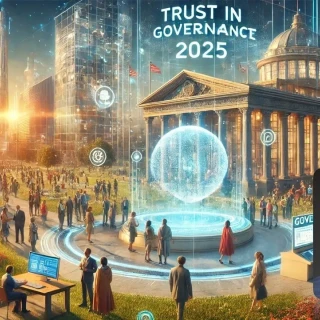Centering Culture in Health and Human Services

Health and Human Services (HHS) agencies across the United States face unprecedented demands. Navigating complexity from shifting federal directives, serving complex and diverse communities, and contending with mounting expectations to modernize service delivery and improve outcomes for our nation’s most vulnerable populations. Transforming these agencies is essential for the continued well-being of communities. While policies and technology play important roles, I’ve witnessed firsthand that the true catalyst for transformation isn’t technology; it’s culture.
This is one release in a series on culture in health and human services systems. The purpose of the series is to articulate the importance of culture and provide a tangible pathway for developing it, with the intent of supporting large-scale HHS transformation. Culture is hard to get right, but when it’s built with intent, it promotes and even accelerates disruptive modernization. Seeing culture change happen firsthand is one of the most rewarding experiences of my life, and it’s possible in America’s most important system.
Foundation
In February of 2023, as Secretary of Human Services for the State of Oklahoma, I convened about a dozen current sitting HHS agency leaders, other Secretaries, and Directors of large systems for a four-hour virtual event to ‘define a national targeted culture in Health & Human Services.’ The attempt was to agree upon core tenets of culture that can be cultivated in these critical agencies across the country. The group agreed on the following four elements of a future national HHS culture.
We are ‘human-centered, outcomes-driven, relationship-focused, trauma-informed, and hope-centered.’ It was noted that each state and agency would likely have additional cultural targets based on various factors; however, the core national culture could be a target for every state in the conversation. Based on this framework, the HHS systems involved are seeking to develop a roadmap for implementing each cultural target, including the identification of both curriculum and measurable outcomes, before launching a culture deployment strategy.
Why Culture Matters
Culture will develop with or without an overarching vision. HHS leaders cannot afford to be passive in shaping this culture; it must be crafted with intention, clarity, and purpose. For frontline HHS staff, their agency’s culture determines whether they feel empowered or constrained. For clients, it affects every interaction, from the warmth of a greeting to the speed and fairness of service delivery, and it impacts their opportunity to feel heard and hopeful in their vulnerable positions.
For HHS agencies, culture influences whether delays are accepted or challenged, whether clients are viewed as cases or people, and whether bureaucracy encourages or stifles innovation. It influences the employee’s experience and the outcomes we can achieve for those we serve. When the culture is misaligned, even the best policies and technologies will fall short. However, when it is intentionally shaped, everything else becomes more effective.
How To Define and Measure Human-Centered Culture
Traditional performance metrics, like application processing times and error rates, are important, but they do not fully capture the experiences of caseworkers or community members navigating the system. A transformed agency measures success not only by the speed of benefit delivery but also by the impact on individuals’ lives. This represents the promise of a human-centered culture, marking a significant shift from compliance-focused bureaucracy to systems that prioritize individual well-being. It emphasizes empathy, dignity, and urgency over rigid processes and traditions, replacing outdated practices with agile, modern approaches that adapt to the evolving needs of those they serve.
We define a human-centered culture as one where:
Empathy is institutionalized and woven into everything from policy design to frontline service delivery.
Outcomes are valued more, or at least as much, as outputs. It’s not so much about checking boxes but achieving tangible, lasting impact for those most important to HHS agencies (clients AND the workforce).
Urgency over inertia; delays are barriers to well-being, not administrative inevitabilities.
Culture doesn’t change through intention alone. It changes through the structure. Human-centered cultures are built through coordinated strategies such as:
Robust, multi-level training that equips staff with tools like personas and journey maps to better understand and serve clients;
Leadership modeling that sets a consistent tone of inclusion, respect, and innovation;
Communities of practice that empower program teams to collaborate, share insights, and pilot improvements in real-time.
Innovation structures that elevate frontline ideas through mechanisms like hackathons and iterative design sessions.
Culture Transformation in Action
The journey towards cultural transformation is intentional. It begins with leadership alignment and extends through system redesign, robust human-centered design (HCD) training, and feedback loops that elevate the voices of clients and employees.
The impact of a human-centered culture can be felt throughout the system, resulting in:
Enhanced client satisfaction: People engage more meaningfully when services align with their real-life journeys.
Improved employee retention: Empowered staff, equipped with the right tools and a clear purpose, will remain and innovate.
Faster, more effective service delivery: Streamlining outdated bureaucratic processes accelerates access and fosters trust.
Increased community well-being: Human-centered cultures create positive ripple effects that promote family stability, self-sufficiency, and health.
What's Next?
Culture influences everything, from the speed of innovation to the level of trust between communities and their government, yet it is often the most underutilized asset in system transformation. Frequently relegated to HR or change management teams, culture should instead be a top priority for agency leadership as a strategic imperative for those seeking to modernize and humanize services.


